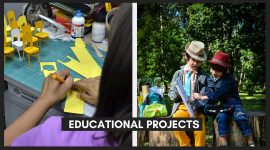Building a positive learning environment for students is a crucial aspect of supporting academic success and overall well-being. In the context of remote learning, homeschooling, or supplementary learning at home, building a positive learning environment is essential for a student’s motivation, focus, and overall growth.
This involves establishing routines, providing necessary resources, fostering a love for learning, and maintaining open communication between parents and students. The goal is to create a space where students feel supported, engaged, and encouraged to explore and excel in their educational journey in boarding schools in Dehradun.
Building a Positive Learning Environment: Nurturing Academic Growth and Well-being
In recent times, the concept of education has expanded beyond the confines of traditional classrooms, with an increasing number of students engaging in learning from the comfort of their homes. Building a positive learning environment at girls boarding schools in Dehradun is essential for fostering academic growth, emotional well-being, and a love for learning.
This article explores the key elements of building such an environment and provides practical strategies for parents and caregivers to support their children’s educational journey.
I. Establishing a Dedicated Learning Space:

Choose a specific area in the home where learning will take place. This should be a quiet space away from distractions, creating a conducive environment for focused study. Involve the student in personalizing their learning space. Allow them to decorate it with motivational quotes, artwork, or organizational tools.
This personal touch creates a sense of ownership and pride in their study area. Proper lighting is crucial for maintaining focus. Ensure that the learning space is well-lit, and provide all necessary supplies such as notebooks, pens, and other materials. A well-equipped space reduces disruptions during study sessions.
II. Establishing a Consistent Routine:

Develop a daily schedule that mimics a school day. Include dedicated time for each subject, breaks, and extracurricular activities. Consistency in routine helps students develop good time-management skills. Breaks are essential for maintaining focus and preventing burnout.
Schedule short breaks between study sessions and incorporate physical activities to energize the body and mind. Begin the day with a positive morning routine. Establishing habits such as morning stretches, a healthy breakfast, and goal-setting can set a positive tone for the rest of the day.
III. Fostering a Positive Mindset:

Promote a growth mindset by emphasizing the value of effort, perseverance, and learning from mistakes. Reinforce the idea that intelligence and abilities can be developed through dedication and hard work. Acknowledge and celebrate achievements, big or small.
Recognizing accomplishments boosts confidence and motivates students to continue putting in effort. When faced with challenges, encourage a positive problem-solving approach. Teach students that setbacks are opportunities for learning and growth. A positive attitude towards challenges fosters resilience.
IV. Cultivating Effective Study Habits:

Guide students in effective time management. Help them break down tasks into manageable chunks, set realistic goals, and prioritize assignments. These skills are crucial for academic success. Encourage active learning strategies such as note-taking, summarizing information, and teaching concepts to others.
Active engagement enhances understanding and retention of information. While technology is a valuable tool for learning, it’s important to set limits on screen time. Create a balance between online and offline activities to prevent digital fatigue.
V. Nurturing a Love for Learning:

Allow students the freedom to explore their interests. Incorporate elements of their passions into the learning environment. This could involve reading books on favourite subjects, engaging in related projects, or watching educational videos. Foster a love for reading by creating a reading-friendly atmosphere at home.
Have a variety of books available, establish a family reading time, and discuss interesting topics to ignite curiosity. Learning doesn’t always have to be conventional. Engage in educational games, experiments, or hands-on activities that make learning enjoyable and memorable by Building a positive learning environment at schools.
VI. Encouraging Independence and Responsibility:

Clearly communicate expectations regarding responsibilities and academic performance. Establish a collaborative approach where students understand their role in the learning process.
Help students develop organizational skills. This includes keeping track of assignments, maintaining a neat workspace, and using tools like calendars or planners to stay organized. Gradually encourage independence in academic tasks.
Allow students to take ownership of their assignments, seek solutions to problems independently, and make decisions about their learning by Building a positive learning environment at schools.
VII. Emphasizing Communication and Support:

Maintain open lines of communication with your child. Encourage them to share their thoughts, concerns, and successes. Being approachable fosters a sense of trust and security. Conduct regular check-ins to discuss academic progress, goals, and any challenges they may be facing.
These conversations provide opportunities for guidance and support. Be proactive in seeking additional support if academic challenges persist. This could involve reaching out to teachers, tutors, or educational resources that specialize in areas where the student may be struggling by Building a positive learning environment.
VIII. Incorporating Social Interaction:

Encourage virtual study groups or collaborative projects with classmates. Social interaction is crucial for emotional well-being and can enhance the learning experience.
Include family learning activities. This could involve group discussions, shared projects, or educational games that involve the entire family. Learning becomes a collective and enjoyable experience. Help students strike a balance between social and academic time.
While studying is important, so is maintaining connections with friends and family. A healthy social life contributes to overall well-being.
IX. Monitoring and Adapting to Individual Needs:
![]()
Conduct regular assessments of the learning environment. Ask for feedback from the student about what is working well and what could be improved. Adjustments can then be made accordingly. Be flexible and willing to adapt the learning environment based on individual needs.
Each student is unique, and building a positive learning environment should cater to their specific strengths and challenges. Instil the value of lifelong learning. Building a positive learning environment should not be confined to academic pursuits but should inspire a love for continuous learning throughout life.
Conclusion
Building a positive learning environment is a holistic endeavour that involves physical space, routines, mindset, and support systems. It requires collaboration between parents, caregivers, and students to create an atmosphere that nurtures academic growth, emotional well-being, and a lifelong passion for learning.
By incorporating the strategies outlined above, families can transform their homes into vibrant centres of education where curiosity is celebrated, challenges are viewed as opportunities, and the joy of learning becomes a lifelong companion for students.









